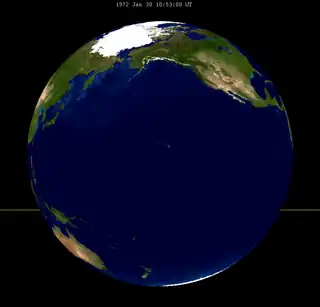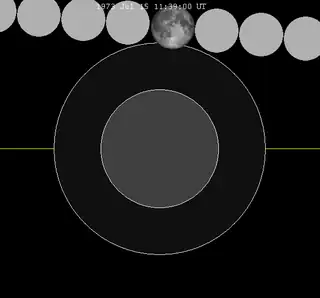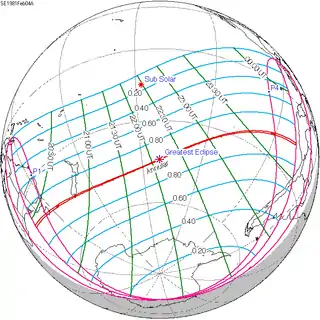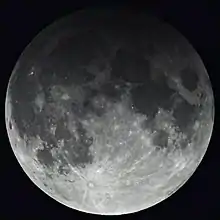| Total eclipse | |||||||||||||||||
| Date | 30 January 1972 | ||||||||||||||||
|---|---|---|---|---|---|---|---|---|---|---|---|---|---|---|---|---|---|
| Gamma | −0.42729 | ||||||||||||||||
| Magnitude | 1.04971 | ||||||||||||||||
| Saros cycle | 133 (24 of 71) | ||||||||||||||||
| Totality | 34 minutes, 47.7 seconds | ||||||||||||||||
| Partiality | 203 minutes, 24.7 seconds | ||||||||||||||||
| Penumbral | 340 minutes, 25.4 seconds | ||||||||||||||||
| |||||||||||||||||
A total lunar eclipse took place on Sunday, January 30, 1972, the first of two lunar eclipses in 1972. The moon entered the Earth's penumbral shadow at 30 January 1972 08:03:12.5 UTC and exited at 30 January 1972 13:43:37.9 UTC. The moon entered the Earth's umbral shadow at 30 January 1972 09:11:38.4 UTC and exited at 30 January 1972 12:35:03.1 UTC. Totality lasted 34 minutes, 47.7 seconds (34.795 min), between 10:35:57.4 UTC and 11:10:45.1 UTC. The moon was 6.6 days before apogee (Apogee on Sunday, February 6, 1972), making it 1.6% smaller than average, only 0.2% larger than the July 1972's lunar eclipse.[1]
Visibility
It was completely visible over eastern Asia, New Zealand, northwestern North America, seen rising over Asia and Australia and setting over North America and western South America.

Relation to other lunar eclipses
Eclipses in 1972
Lunar year series
| Lunar eclipse series sets from 1969–1973 | ||||||||
|---|---|---|---|---|---|---|---|---|
| Ascending node | Descending node | |||||||
| Saros | Date Viewing |
Type Chart |
Gamma | Saros | Date Viewing |
Type Chart |
Gamma | |
| 108 | 1969 Aug 27 |
Penumbral |
−1.54066 | 113 | 1970 Feb 21 |
Partial |
0.96198 | |
| 118 | 1970 Aug 17 |
Partial |
−0.80534 | 123 | 1971 Feb 10 |
Total |
0.27413 | |
| 128 | 1971 Aug 6 |
Total |
−0.07944 | 133 | 1972 Jan 30 |
Total |
−0.42729 | |
| 138 | 1972 Jul 26 |
Partial |
0.71167 | 143 | 1973 Jan 18 |
Penumbral |
−1.08446 | |
| 148 | 1973 Jul 15 |
Penumbral |
1.51782 | |||||
| Last set | 1969 Sep 25 | Last set | 1969 Apr 2 | |||||
| Next set | 1973 Jun 15 | Next set | 1973 Dec 10 | |||||
Half-Saros cycle
A lunar eclipse will be preceded and followed by solar eclipses by 9 years and 5.5 days (a half saros).[2] This lunar eclipse is related to two annular solar eclipses of Solar Saros 140.
| January 25, 1963 | February 4, 1981 |
|---|---|
 |
 |
See also
Notes
- ↑ Saros series 133
- ↑ Mathematical Astronomy Morsels, Jean Meeus, p.110, Chapter 18, The half-saros
External links
- 1972 Jan 30 chart Eclipse Predictions by Fred Espenak, NASA/GSFC

_(cropped).jpg.webp)
